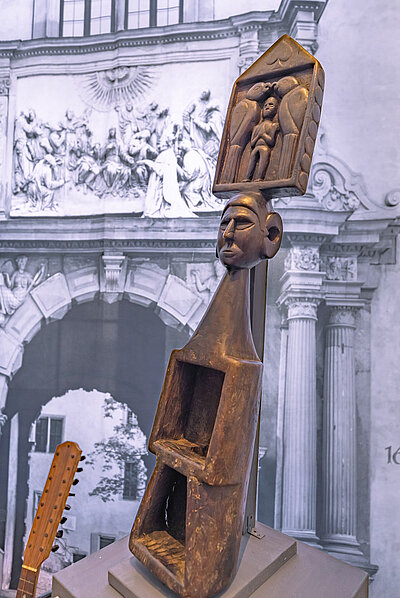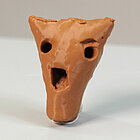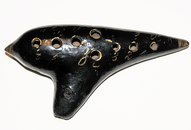Station II: More than Material

quena : Peru, mid-20th century, wing bone of an Andean condor (vultur gryphus).
To produce sound, the player closes the top end of the pipe with the flesh between the chin and lower lip, and blows a stream of air downward, along the axis of the pipe, over an elliptical notch cut into the end. – Instruments like this remind us that the time period between the Geissenklösterle and the modern flute is extremely short compared to the development of animal species.
Inv. Nr.: SMM Lo 27
waqra phuku : (Quetchua: “horn” and “blow”), Peru, mid-20th century.
Ten to 16 pieces of horn are spiraled together and fixed with wax or leather strips. Cattle (bos taurus) were introduced to South America by the Spaniards in the sixteenth century. The horn is traditionally used in annual fertility rituals. Its sound also opens the competitive festivals of the tropas (of tarka flute players) during the humid season of the year.
Inv. Nr.: SMM Lo 99
Cattle horn harp : Western Africa, cultural affiliation unclear, 20th century.
A pumpkin calabash is used as resonator, the soundboard made from cowhide, the attachment of the soundboard is decorated with cowrie shells (cypraeidae). Two holders made from leather end in tufts of goat hair. Cow horns can be used in many ways. They also serve as resonators for spike lutes.
Inv. Nr.: SMM De 393
horagai : Conch trumpet (charonia tritonis), Japan, mid-20th century.
The conch is used by Buddhist monks for religious purposes. Its use goes back at least 1000 years, and it is still used today for some rituals, such as the omizutori (water drawing) portion of the shuni-e rites at the tōdai-ji in Nara. – Shell horns were widely used worldwide from early times. The tomb find of such an instrument from Ösel, Lower Saxony, makes a trade of the European mainland with Mediterranean areas around 3000 bc probable.
Inv. Nr.: SMM G 19
cimpoi : Bagpipe, Romania, ca. 2000.
The bag (burduj) is made from the entire skin of a goat (capra). The two pipes have idioglot reed tongues. The player blows through a tube into a leg hole to fill the bag. The drone pipe is attached to the other front leg hole. The place of the head is reserved for the melody pipe.
Listen to the playing of the Cimpoi at the National Village Museum, Bucharest, Romania.
Inv. Nr.: SMM De 628
quijada : Peru or Bolivia, 20th century.
Lower jaw of a donkey (equus asinus asinus), percussion ideophone and scraper (“quijada golpeada y raspada”). A piece of bone is used to scrape along the teeth (“raspador de hueso”).
What is a Quijada? Music Museum Online (Youtube)
Inv. Nr.: SMM De 529
kundi harp : Democratic Republic of Congo, early 20th century.
The ivory neck is attached in grommet stock to a boat-shaped resonator covered with python skin. This type of ostentatious harp appeared around 1900 in the course of colonial trade and served European clichés of jungle and big game hunting. The carving on the neck shows a baboon carrying a jug on its head while sitting on the shoulders of a man. The motif fits into a series of ironic depictions in which the carvers could also criticize the Belgian colonial masters.
Inv. Nr.: SMM De 598
One piece of wood: dhodro banam, Northeast India, 20th century. Inv. Nr. SMM De 570.
The top finial shows a human figure with hands placed together in an attitude of prayer under two beaking doves.
The folk music instrument dhodro banam (“hollow instrument”) belongs to the sarinda lute family. It can be found in Iran, Pakistan, Nepal and Northern India (with a probable origin somewhere in Central Asia). It is mainly used by the Santal, a tribal group from India (Bihar, Orissa, West Bengal). It consists of a soundbox, which is split into two parts, the lower part sometimes covered with skin, a neck, an often rectangular peg box topped with a large, ornately carved boardlike finial. It has one string and is played with a bow in a vertical position.
The instrument’s sound is said to be reminiscent of the human voice to the Santal people. Its appearance varies greatly, often taking human form. A Santal myth recounts how the wood for the first dhodro banam came from a tree that grew from the grave of a human being. The Santal believe that the instrument is a gift from supernatural forces that allows them to communicate with entities from other worlds. They also believe that they are physically related to the instrument and consider it to be a human being. The dhodro banam is usually adorned with depictions of human figures, often in scenes of everyday life. Sometimes the figures are groups of dancing women, who are portrayed performing a dance related to fertility. When animals appear, they are usually shown as beasts of burden ridden by humans. These instruments can also be decorated with lines and symbols. Later owners might add ornamentation, such as animals. Currently it is not possible to determine whether the stylistic features are local variations, the fashion of a particular era, or the individual styles of different carvers.
See dhodro and huka banam players at Lakshmipur village, Birbhum, District West Bengal, India. Recording (uploaded on Youtube) from Daricha Foundation, Kolkata
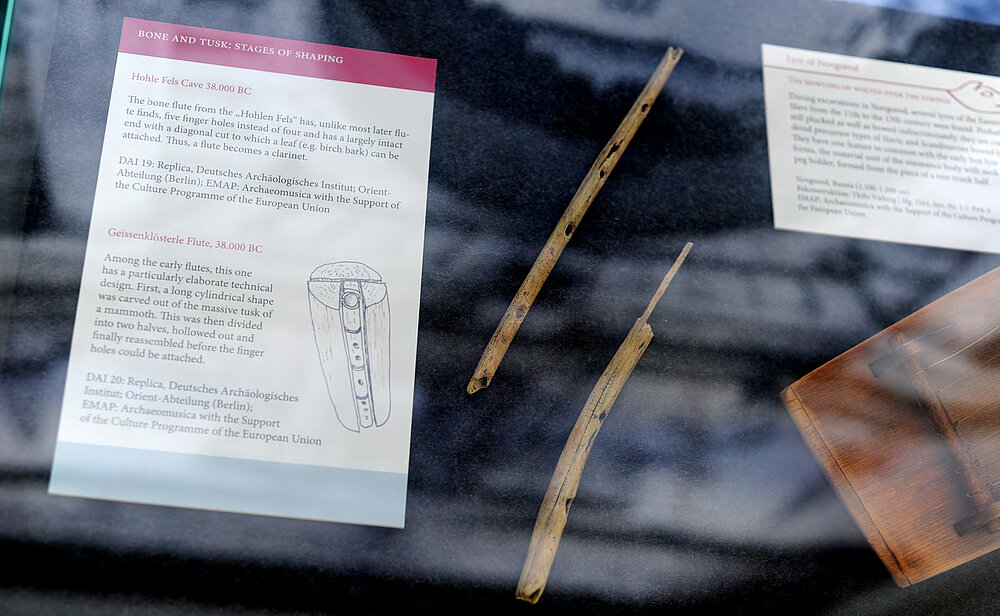
SHOWCASE – Stages of shaping [find object plates here]
Bone and tusk
Hohle Fels Cave 38.000 BC
The bone flute from the „Hohlen Fels“ has, unlike most later flute finds, five finger holes instead of four and has a largely intact end with a diagonal cut to which a leaf (e.g. birch bark) can be attached. Thus, a flute becomes a clarinet.
DAI 19: Replica, Deutsches Archäologisches Institut; Orient-Abteilung (Berlin); EMAP: Archaeomusica with the Support of the Culture Programme of the European Union
Geissenklösterle Flute, 38.000 BC
Among the early flutes, this one has a particularly elaborate technical design. First, a long cylindrical shape was carved out of the massive tusk of a mammoth. This was then divided into two halves, hollowed out and finally reassembled before the finger holes could be attached.
DAI 20: Replica, Deutsches Archäologisches Institut; Orient-Abteilung (Berlin); EMAP: Archaeomusica with the Support of the Culture Programme of the European Union
The howling of wolves over the strings
During excavations in Novgorod, several lyres of the Eastern Slavs from the 11th to the 13th century were found. Probably still plucked as well as bowed indiscriminately, they are considered precursor types of Slavic and Scandinavian bowed lyres.—They have one feature in common with the early box lyre forms, the material unit of the resonance body with neck and peg holder, formed from the piece of a tree trunk half. – Novgorod, Russia (1.100-1.200 AD)
Rekonstruktion: Thilo Viehrig | Slg. DAI, Inv.-Nr. I‐1‐Po4‐3; EMAP: Archaeomusica with the Support of the Culture Programme of the European Union
Is this a face?
Replica of the vascular flute from Uruk (4th to 3rd mill. BC) with reconstruction of the labium. Original: Uruk-Warka Collection of Heidelberg University, W 21790. 3D modelled and printed for the exhibition „MUS-IC-ON! Sound of Antiquity“ at the Martin von Wagner Museum in 2019 by Johannes Väthjunker. How it might have sounded?
SMM W 34
Ocarina: little goose
Clay pipes to imitate bird calls were popularly sold at Italian fairs in the 19th century. From this, the potter Giuseppe Donati from Budrio developed the concert ocarina around 1850. His ocarina ensemble started a European tour in Vienna in 1873 in the Circus Renz, which triggered an ocarina boom in all the countries visited.
Ocarina, Vienna around 1900
SMM R 27
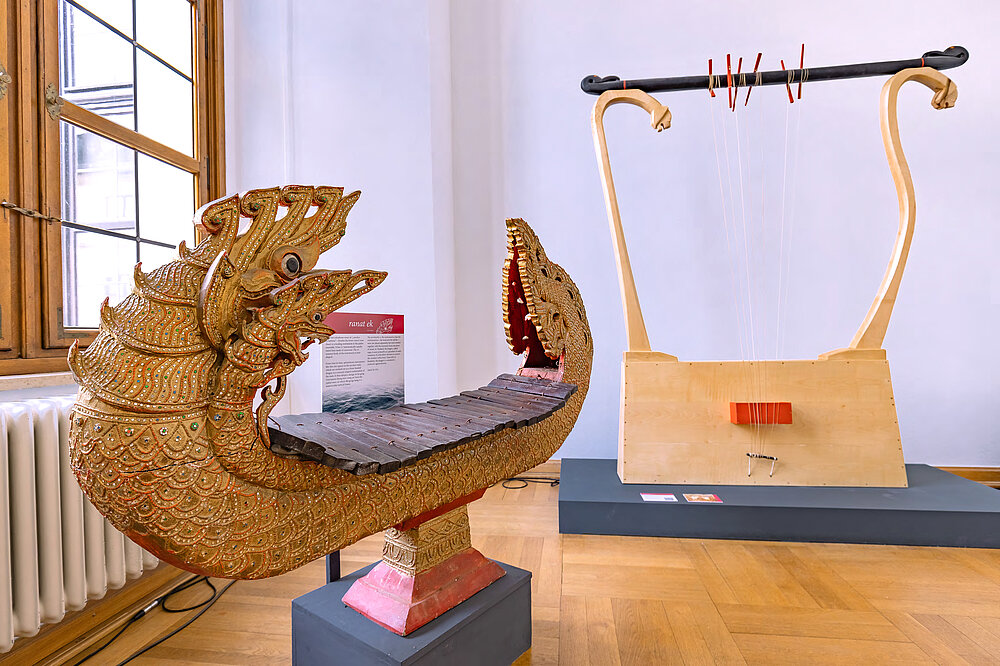
Monsters and Gods – made from wood
The Thai xylophone ranat ek (literally „another xylophone“—besides the lower tuned ranat thum) is a leading instrument in the piphat ensemble. It has 21 heptatonically equally tuned bars made of rosewood. The resonance body of the instrument is boatshaped. From time to time, splendorous instruments like this one appear in the auction trade, which are worked out as a three-headed dragon in a crescent-shaped continuation of the ends. It thus adopts a design of the gong instrument khong mon wong yai from the piphat mon, in which the gongs hang in a semicircular vertical frame.
SMM De 532: The peculiarity of this instrument is that the continuations—the head and the tail fin—were not placed separately, but were worked together with the resonator from one piece of wood. In Thailand, the dragon, called naga, is seen primarily as a guardian of water resources. It is therefore obvious to connect the creature with a boat. Especially in Buddism, the dragon is considered a protector against storms. (May it protect our collection from coming tempests.)
The Instrument as god. Relief vase from İnandıktepe (Turkey) with four relief bands depicting a hittie ritual, 16th century BC.
Museum of Anatolian Civilizations, Ankara (Photo on Poster ©: alamy)
Gigantic box lyres were used in the cult as divine mediators to soothe the hearts of restless gods. The decoration of the cross yoke with duck or horse heads points to Egyptian influences (see the horses station).
Reconstruction: Ralf Gehler (Schwerin) for MUS-IC-ON!
Foundation of the Alumni Würzburg
See the description at MUS-IC-ON!






